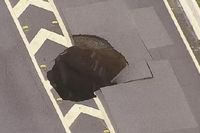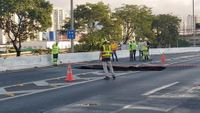A deep crater opened on the Marginal Tietê in São Paulo on Thursday, April 10, 2025, causing significant disruption to traffic in one of the city’s busiest areas. The incident occurred after heavy rains hit the region, leading to a failure of the asphalt and the formation of the crater near the Tietê Plaza shopping mall in the Jardim Iris neighborhood.
The crater occupies part of the central lane, located approximately 400 meters before the Atílio Fontana Bridge, and has resulted in a total closure of this lane heading towards the Castello Branco highway at the exit of the Bandeirantes highway. The Companhia de Engenharia de Tráfego (CET) has advised motorists to use the local and express lanes as alternatives while their agents manage traffic in the area.
According to the CET, the incident was classified as an "undermining," a type of erosion that causes the ground to sink. This particular section of the road is under the jurisdiction of the CCR AutoBAn, which has stated that its teams are on-site providing support to the CET and Sabesp, the water and sewage company, as they assess the situation and determine the cause of the problem.
As the crater opened, the city was already experiencing severe weather conditions, with heavy rainfall causing widespread flooding alerts across São Paulo. The entire metropolitan area entered a state of alert for potential flooding, as the rains intensified in the early afternoon. The CGE (Centro de Gerenciamento de Emergências Climáticas) indicated that conditions for isolated storms and heavy rainfall would persist into the evening hours.
In addition to the crater, the heavy rains led to numerous reports of fallen trees across various neighborhoods, with the Fire Department responding to at least 21 calls regarding these incidents. Areas affected included Itaim Bibi, Pinheiros, Itaquera, Carrão, Penha, Vila Matilde, and Mandaqui. In particular, the Tucuruvi neighborhood reported two separate incidents of flooding.
Despite the severity of the situation, authorities have confirmed that there have been no reports of injuries related to the crater or the flooding. However, the impact on traffic has been significant, with congestion reported in multiple areas as drivers are redirected away from the central lane of the Marginal Tietê.
Images and videos from the scene show the extent of the damage to the asphalt, highlighting the challenges faced by city officials in managing the aftermath of the heavy rains and the crater’s formation. The CET continues to monitor the situation closely, working in coordination with local emergency services to ensure public safety.
The cause of the crater remains under investigation, and while there is no confirmed link to the recent heavy rains, the timing of the incident raises concerns about the infrastructure's resilience in the face of severe weather. As São Paulo grapples with these challenges, residents are urged to remain vigilant and heed the advice of local authorities regarding travel and safety.
In summary, the opening of the crater on the Marginal Tietê has not only disrupted traffic but also highlighted the vulnerabilities in urban infrastructure during extreme weather events. With ongoing assessments and repairs expected, the city is facing a critical period in addressing both immediate concerns and long-term solutions to prevent similar occurrences in the future.










